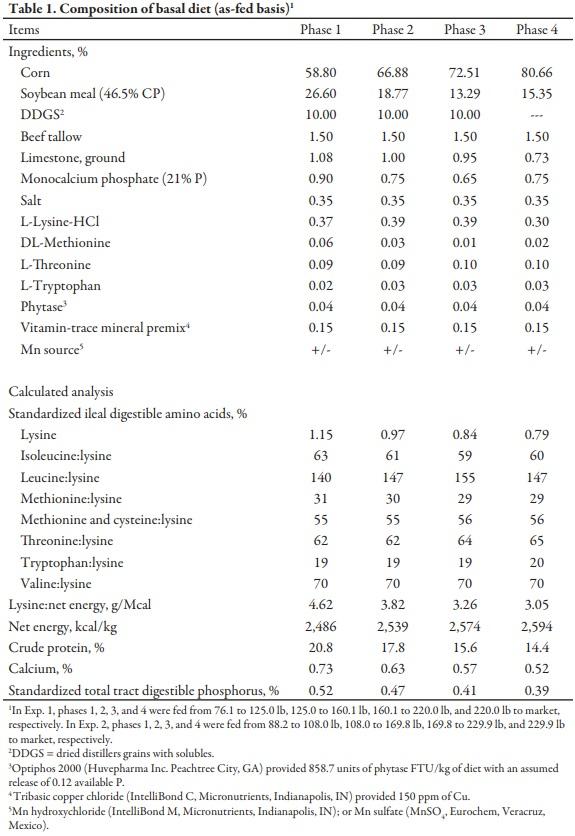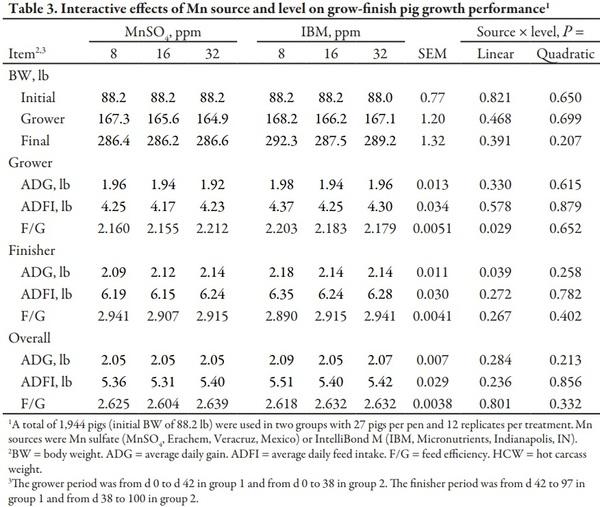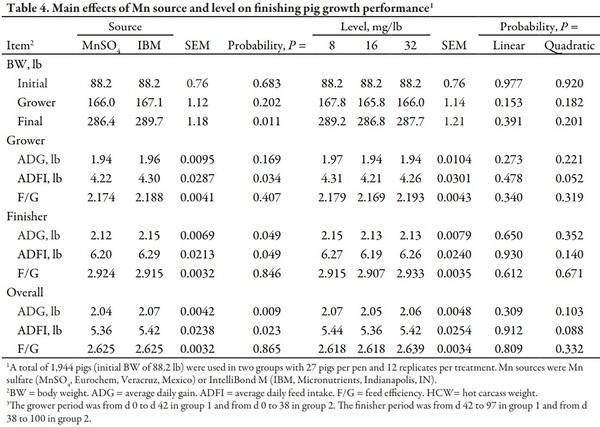Introduction
Manganese is an essential trace mineral that is a key component in carbohydrate, lipid and protein metabolism. According to the NRC,2 the quantitative requirement for Mn for nursery and finishing diets ranges from 2 to 4 ppm. Assuming bioavailability is not a concern, many swine diets today meet the NRC2 estimated requirement for Mn from the major dietary ingredients before a trace mineral premix is added to the diet. However, due to the unknown bioavailability of the innate Mn in ingredients, swine diets typically contain added Mn through a trace mineral premix. In a survey conducted by Flohr et al.,3 swine diet Mn levels were found to be supplemented at as low as 3.3 ppm and as high as 40 ppm throughout the entire finishing period. Therefore, there is a wide discrepancy of Mn supplementation in commercial swine diets.
In a previous study, we evaluated the effects of increasing Mn from MnSO4 or Mn hydroxychloride (IBM; Micronutrients, Indianapolis, IN).1 In that study there was no evidence of differences observed between the two Mn sources; however, these diets did not contain high levels of added Cu. Therefore, the objective of this study was to further determine the effects of increasing dietary levels of Mn and the source of Mn on growth performance of growing-finishing pigs fed diets with high levels of added Cu.
Procedures
The Kansas State University Institutional Animal Care and Use Committee approved the protocols used in this experiment.
Animals and Diets
This study was conducted in two barns at a commercial research-finishing site in southwest Minnesota (New Horizon Farms, Pipestone, MN). Each barn was naturally ventilated and double-curtain-sided with a slatted concrete floor and deep manure storage. Each pen (10 × 18 ft) was equipped with a 5-hole stainless steel dry self-feeder (Thorp Equipment, Thorp, WI) and a bowl waterer for ad libitum access to feed and water.
Two groups of 972 pigs (1,944 total pigs, PIC 337 × 1050; initial BW 80.2 lb) were used in a 100-d growth trial. Pigs were housed in mixed gender pens with 27 pigs per pen and 12 pens per treatment. Daily feed additions to each pen were achieved by using a robotic feeding system (FeedPro; Feedlogic Corp., Wilmar, MN) able to record feed amounts for individual pens. The treatments were structured as a randomized complete block design and arranged in a 2 × 3 factorial with main effects of Mn source (MnSO4 , Eurochem, Veracruz, Mexico; or Mn hydroxychloride, IBM; IntelliBond M, Micronutrients USA, LLC, Indianapolis, IN) and increasing Mn (8, 16, or 32 ppm). All treatment diets were manufactured at the New Horizon Farms Feed Mill in Pipestone, MN, and were formulated to meet or exceed NRC2 requirement estimates for growing-finishing pigs for their respective weight ranges (Table 1). Diets were fed in meal form and in 4 dietary phases within each experiment.
Experimental diets were corn-soybean meal-DDGS-based and were formulated with premix without Mn, Cu, and Zn. Manganese, Cu, and Zn were added to the diet by hand-made premixes, which were added in place of corn in the diet. Each hand-made addition contributed the desired source of Mn, MnSO4 or IBM, and Mn level, 8, 16, or 32 ppm to the appropriate treatment, along with hand additions to provide 150 ppm of Cu from IntelliBond C (Micronutrients, Indianapolis, IN) and 80 ppm of Zn from IntelliBond Z (Micronutrients, Indianapolis, IN).
Pigs were weighed approximately every 14 days to determine ADG, ADFI, and F/G. Because of the ongoing outbreak of COVID-19, only final weights were obtained, and no carcass data were collected.
Chemical Analysis
Representative diet samples were obtained from all feeders of each treatment and delivered to the Kansas State University Swine Laboratory, Manhattan, KS, and stored at -20°C until analysis. Samples of the diets were combined within dietary treatment, and two composite samples from each treatment were analyzed in duplicate (Cumberland Valley Analytical Services, Hagerstown, MD). Samples were analyzed for Mn, Cu, and Zn content (Method 985.01; AOAC Int., 2000).4
Statistical Analysis
Data were analyzed as a randomized complete block design for one-way ANOVA using the lmer function from the lme4 package in R (version 3.5.1 (2018-07-02), R Foundation for Statistical Computing, Vienna, Austria) with pen considered the experimental unit, BW as blocking factor, and treatment as fixed effect. Predetermined orthogonal contrasts were used to evaluate the interactive effects of Mn source and level. Interactions (P ≤ 0.10) were evaluated linearly or quadratically within the source. All results were considered significant at P ≤ 0.05 and marginally significant between P > 0.05 and P ≤ 0.10.
Results
The analyzed dietary Mn, Cu, and Zn were consistent with calculated values used in diet formulation and followed the intended Mn titration additions (Table 2).
High levels of Cu were included in all diets and in the grower period, there was an Mn source × level interaction (linear, P = 0.029) observed for F/G, with F/G improving as Mn increased from IBM, but decreasing with increased Mn from MnSO4. There was no evidence (P > 0.10) for Mn source or Mn level effect on ADG, but ADFI was greater (P = 0.034) when Mn was provided by IBM. Pigs fed 16 ppm Mn tended (P = 0.052) to have decreased ADFI when compared to those fed 8 or 32 ppm, regardless of source.
In the finisher period, there was an Mn source × level interaction (linear, P = 0.039) for ADG, with ADG improving as supplemental Mn was increased for MnSO4 but decreasing when Mn was increased for pigs fed IBM. There was no evidence (P > 0.10) of difference for Mn level to influence ADFI, but ADFI was greater (P = 0.049) for pigs fed Mn from IBM compared to pigs fed Mn from MnSO4. There was no evidence of difference (P > 0.10) for an Mn source or level effect on F/G in the finisher period.
Overall, there was no evidence (P > 0.10) for an Mn source × level interaction for final body weight or any observed growth responses. Pigs fed Mn provided by IBM had greater (P < 0.05) ADG and ADFI and heavier (P < 0.05) final BW than pigs fed Mn from MnSO4. Regardless of the source, pigs fed 16 ppm of Mn tended (quadratic, P = 0.088) to have lower overall ADFI than pigs fed 8 or 32 ppm of Mn. There was no evidence of difference (P > 0.10) for Mn source or level effect on F/G.
Discussion
According to the NRC,2 the Mn requirement estimate for growing-finishing pigs is 2 to 4 ppm of the diet. However, most of the research for determining the Mn requirement was conducted more than 50 years ago. Due to the unknown bioavailability of Mn from ingredients commonly used in diets, Mn is usually added to swine diets through a trace mineral premix, frequently as MnSO4. Manganese hydroxychloride is another source of Mn that can be added to trace mineral premixes for swine diets. Hydroxychloride-based minerals are manufactured through the reaction of hydrochloric acid, high purity forms of metal, and water. The products of this reaction are hydroxychloride crystals that contain the desired metal covalently bonded to chloride and hydroxyl groups. The covalent bonds processed by hydroxychloride minerals reduce the ability for the minerals to react with other components of the diet and potentially improve bioavailability.5
In a previous study, there was no main effect of Mn source on any influence growth performance or carcass characteristics; however, in the present study pigs fed supplemental Mn from IBM had increased ADG and ADFI and heavier final BW when compared to pigs fed MnSO4. The reason for these inconsistent effects of IBM on growth performance was not clear, but could have been a result of the higher levels of dietary Cu in the present experiment. Pharmacological levels of Cu have been shown to improve growth performance in growing-finishing pigs.6 Copper is excreted from the body through bile. However, when dietary Mn was increased to 200 ppm in rats, Mercandante et al.7 observed a reduction in Cu levels in the bile, signifying a hepatobiliary metabolism relationship between Mn and Cu. With the potential of improved bioavailability of the Mn hydroxychloride, less Cu may have been excreted, allowing for potentially greater utilization of Cu in pigs being fed Mn hydroxychloride. However, this theory warrants further investigation.
In summary, our results suggest that supplementing growing-finishing diets with greater than 8 ppm of Mn did not lead to any improvements in growth performance. Pigs fed Mn provided by IBM had greater ADG, ADFI, and heavier final BW than pigs fed Mn from MnSO4. More research is needed to further understand the potential benefits of Mn hydroxychloride fed in conjunction with high levels of Cu on pig growth performance.
Brand names appearing in this publication are for product identification purposes only. No endorsement is intended, nor is criticism implied of similar products not mentioned. Persons using such products assume responsibility for their use in accordance with current label directions of the manufacturer.
This article was originally published in Kansas Agricultural Experiment Station Research Reports: Vol. 6: Iss. 10. https://doi.org/10.4148/2378-5977.8000. This is an Open Access article licensed under a Creative Commons Attribution 4.0 License. 













.jpg&w=3840&q=75)